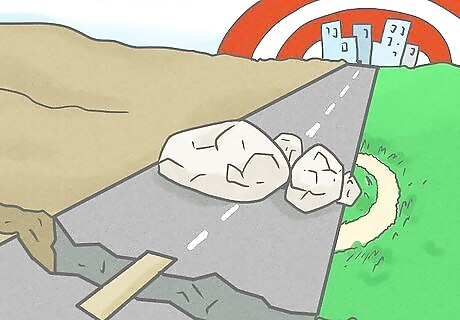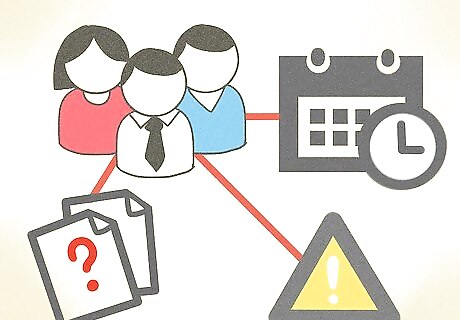
views
Developing Ideas

Develop a meaningful mission. A mission statement that matters will introduce a new sense of meaning to your work. When you feel that your work has value, it will be easier to invest more time and energy. Mission statements also serve as helpful guides when you develop new ideas. Coming up with an innovative idea can be intimidating when you're staring at a blank sheet of paper. A mission statement puts something on that paper for you to work from, which can make the brainstorming process easier. When it's time to brainstorm a new idea, turn to your mission statement and ask yourself if there are facets that have not yet been adequately addressed. Start working from whichever aspect of your mission is currently weakest.

Question everything. Ask questions about everything, even the things you already think you know. You may discover a new way to approach something you previously believed to be set in stone. Try looking at something you do each day. Ask yourself who else does it and how they might do it differently. There are many ways to approach most tasks, and if you assume that yours is the best, you're taking a fairly big risk. When analyzing different methods, ask yourself why the person who started the method chose to pursue it. Consider whether other alternatives were considered and rejected. Also ask yourself if other assumptions or constraints limited that source's actions. Concerning both familiar and unfamiliar methods, ask yourself what your complaints are about those methods and what your friends' or colleagues' complaints might also be.

Gain firsthand knowledge. “Book learning” is great, but it will only take you so far. Only by getting out into the field and gaining firsthand knowledge of the way things really work can you hope to understand how to streamline and improve on things within that field. Keep in mind that the knowledge available in books was first discovered by people who didn't have such books to work with. They were people who experienced matters for themselves, and their experiences brought about information that would last beyond their own lifetimes. No two people see the world in exactly the same way. By viewing or experiencing something for yourself, you bring your own unique set of questions and beliefs to the table. As such, you might be able to make observations no one else has made yet. Some unique observations may lead nowhere, but others can lead you toward new innovations within the field.

Care about your customers. It pays to get inside your customers' heads. Standard customer service will only benefit you so much, though. You'll need to care about your customers as much as you care about their patronage if you want to think up new ways to address their needs and wants. Get to know your customers as thoroughly as your resources will allow. Try not to rely on secondhand accounts provided by consultants or research. Instead, connect with your customers directly. When you start from scratch, your official market doesn't exist yet. You'll need to spend time getting to know prospective customers in your target market, as well as prospective partners and suppliers.

Keep your eyes and ears open. Gain inspiration from as many sources as possible. New ideas won't necessarily strike during the time you've allotted for inspiration. They often come when you least expect them to do so, and may even come from sources you'd never expect. If you're working with others in a shared space, try posting an idea board in an area everyone passes by. The people in your team can post problems and ideas to the board. Other teammates should respond to those issues as they see fit. This continual exchange of knowledge can lead to new and exciting ideas. Listen to others and hear what they have to say about some of the issues you're working on. You don't need to directly ask them for help with your project, but by observing the complaints and concerns they express, you might gain a better perspective on how to approach the matter.
Building Success

Use data to support your instincts. Your instincts may suggest that something is a great idea, but you won't really know whether or not it's worth pursuing until you gather data around that subject. Sometimes the data will support your instincts, but other times, it may prove your instincts to be wrong. Customer surveys and product tests are both great ways to collect data on your ideas. These tools provide you with data specifically tailored to your project and your target market.

Introduce new options. When “Option A” and “Option B” are the two clearest, most obvious choices, it can be easy to assume that they're the only choices. There might be new, less obvious choices that are better and waiting to be discovered just outside of the box, however. "Option A" and "Option B" might be standard procedures that are hard to break from. In that case, question why those procedures are standard. Point out any weaknesses or flaws in those options and suggest ways to address those issues.

Take small, immediate steps. If you wait until you have the means to enact a big plan all at once, you'll be waiting a long time and will likely lose momentum as you sit around. A better course of action is to commit as quickly as possible by taking small steps toward your goals. Give tangible form to abstract ideas as quickly as possible. Create a prototype of a project you're working on. Improve the actual prototype instead of trying to make all of your improvements only on paper. Major innovation is even harder to pull off during tough economic times since your resources are slim and your customers are more resistant to change. Investing everything you have in a major innovation without approaching it in a few minor, cautious steps can be a waste of resources you need to manage more effectively. Taking small steps will allow you to change direction along the way as needed.

Look at the big picture. Small steps and short-term goals are important when you're trying to build momentum, but if you want long-term success, you will need to make sure that your goals will lead you to your desired long-term goal. Don't let yourself be blinded by short-term gains. If those gains will come with unsavoury long-term consequences, it is usually best to pass them by.

Try to try again. Failure is inevitable, but each failure can act as a learning experience. Learn from your past failures and press forward with new strategies and ideas. Never expect immediate perfection. When you introduce something new, wait for feedback. The entire thing might be a failure, but more often than not, there are at least redeemable aspects that will be worth preserving and building upon in the future.
Inspiring Your Team

Separate into small teams. When working within a group of people, separate yourselves into smaller teams before tackling a large project or problem. Small teams are more focused, so they tend to get work done faster and more effectively than large, mismatched groups can. If a new venture requires expertise from several fields, consider creating multiple small teams to handle each of these aspects separately. For instance, one team might handle quality assurance while another might handle the legalities. Representatives from the teams will need to meet occasionally, but most of the work can be done separately.

Improve communication between groups. Even though different aspects of a project or company should be primarily handled by different teams, each team will likely have information that could benefit another group. The separate teams must communicate with each other regularly and effectively. Information that can benefit other teams within the larger group should be shared freely. If one team has to search for an answer another team already knows, they end up wasting time that could have been spent better elsewhere.

Introduce a few constraints. Oddly enough, creativity tends to thrive when it faces a little opposition. A few constraints and project parameters can provide team members with just enough of a foundation to build on. The key is to constrain without suffocating or starving your team. Introduce specific problems that need to be fixed and outline the sort of approach you're looking for. Do not pressure the team with unnecessary restrictions on time and funding. Additionally, if someone figures out a way to approach the problem that differs from your outline but still works effectively, take that concept into consideration rather than rejecting it outright.

Encourage risk. Innovative minds rarely play it safe. There will be a considerable amount of risk involved at the beginning of a project. The sooner you accept that the sooner you can encourage the rest of your team to accept it. Pitch ideas in a manner that minimizes the perceived risk of trying them while emphasizing the risk of not trying them. Make your teammates (and, by extension, your customers) believe that they will be making a big mistake if they don't jump on the idea you're presenting.

Reward risk reduction. Risk is inevitable, but ultimately, you want to reduce the amount of risk a project faces as you continue to build upon it. Providing extra incentives can encourage workers to focus on ways to reduce the risk without compromising the entire project. Monetary incentives can be quite effective. When you're in a position that allows you to make the decisions about how to funds are distributed, start by giving each group the finances it needs to overcome some of the initial risks and uncertainties. As these risks are cleared, grant the group more funding to work with.

















Comments
0 comment